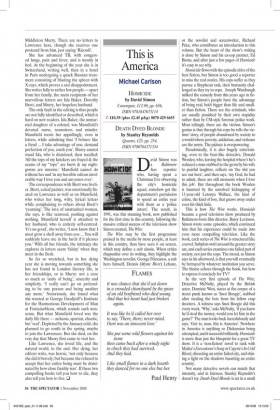This is America
Michael Carlson
HOMICIDE by David Simon Canongate, £12.99, pp. 656, ISBN 9781847673114 ✆ £10.39 (plus £2.45 p&p) 0870 429 6655 DEATH DYED BLONDE by Stanley Reynolds Quartet, £25, pp. 254, ISBN 9780704371354 David Simon was a Baltimore Sun reporter who, having spent a Christmas Eve observing the city’s homicide squad, somehow got the department’s permission to spend an entire year with them as a ‘police intern’. The result, in 1991, was this stunning book, now published for the first time in this country, following the massive critical success of the television show Simon created, The Wire.
The Wire may be the first programme praised in the media by more people, at least in this country, than have seen it on screen, which may define a cult classic. When critics rhapsodise over its writing, they highlight the Washington novelist, George Pelecanos, a cult hero himself, Dennis (Mystic River) Lehane, or the novelist and screenwriter, Richard Price, who contributes an introduction to this volume. But the heart of the show’s writing is done by Simon and his ex-cop partner, Ed Burns, and after just a few pages of Homicide it’s easy to see why.
Homicide flows with the episodic drive of the best fiction, but Simon is too good a reporter to miss the real stories. His cops suffer as they pursue a Sisyphean task, their humanity challenged as they try to cope. Joseph Wambaugh milked the comedy from this years ago in fiction, but Simon’s people have the advantage of being real, both bigger than life and smaller than fiction. There are the criminals, who are usually punished by their own stupidity rather than by CSI-style forensic police work. Most tellingly, there are the victims. Simon’s genius is that through his cops he tells the victims’ story, of people abandoned by society to a world where poverty, addiction, and violence are the norm. The picture is overpowering.
Paradoxically, it is also hugely entertaining, even to the bear-like detective, Donald Worden, who, leaving the hospital where’s he’s reduced a man stabbed in the groin by his wife to painful laughter, reflects on ‘the shit you see out here’, and then says, ‘my God, he had to admit, there are still moments when I love this job’. But throughout the book Worden is haunted by the unsolved kidnapping of 11-year-old Latonya Wallace, the kind of crime, the kind of loss, that gnaws away under even his thick hide.
This is how The Wire works. Homicide became a good television show produced by Baltimore-born film director, Barry Levinson. Simon wrote some episodes, which convinced him that his experience could be made into even more compelling television. Like the book, each series of The Wire is structured like a novel. Subplots swirl around the greater story arc, and each series examines one failed part of society, not just the cops. The moral, as Simon says in his afterword, is that you will eventually be betrayed by whatever institution you serve. The theme echoes through the book, but how to express it concisely for TV?
In the very first episode of The Wire, Detective McNulty, played by the British actor, Dominic West, stares at the corpse of a street punk known as ‘Snot Boogie’, stabbed after stealing the bets from his fellow crap shooters. A witness says Snot Boogie did this every week. ‘Why,’ asks McNulty, ‘if you knew he’d steal the money, would you let him in the game?’ The man looks back incredulously and says, ‘Got to, man, this is America’. Nowhere in America is anything so Dickensian being attempted, and it succeeds brilliantly. Homicide is more than just the blueprint for a great TV show. It is a ‘non-fiction’ novel to rank with Mailer’s Executioner’s Song or Capote’s In Cold Blood, dissecting an entire failed city, and shining a light on the shadows haunting an entire country.
Not many detective novels can match that intensity, and in fairness, Stanley Reynolds’s doesn’t try. Death Dyed Blonde is set in a small New England town, and its three murders are far beyond the norm for Chief Parker ‘Boomer’ Daniels. Michael Frayn praises the novel’s use of ‘the American language’, but although there is much snappy repartee, and Robert B. Parker-style ironic punchlines to most scenes, it’s the reparatee of 1930s movies. Boomer gets most of the good lines, though his name must be ironic; he’s soft-spoken and self-effacing to the point where one realises that he really has stepped from the pages, not of Dashiell Hammett but Agatha Christie, and his surface confusion won’t stop him from solving the crimes.What Reynolds has put into his rural New England is an old-fashioned English country-house mystery. His small town boasts both a legendary Hollywood actress and a baseball star. Each new character turns out to be something or someone else, and all are tied to the victim. One killing is a ‘locked-room’ mystery, and Boomer solves the crime by staging a phony séance, then gathering everyone together to explain the murder. That one of the killers and the solution to the locked-room puzzle are both rather obvious shouldn’t lessen the enjoyment these parlour games offer. If it’s much more Murder She Wrote than The Wire, there’s nothing wrong with that. q



































































































 Previous page
Previous page